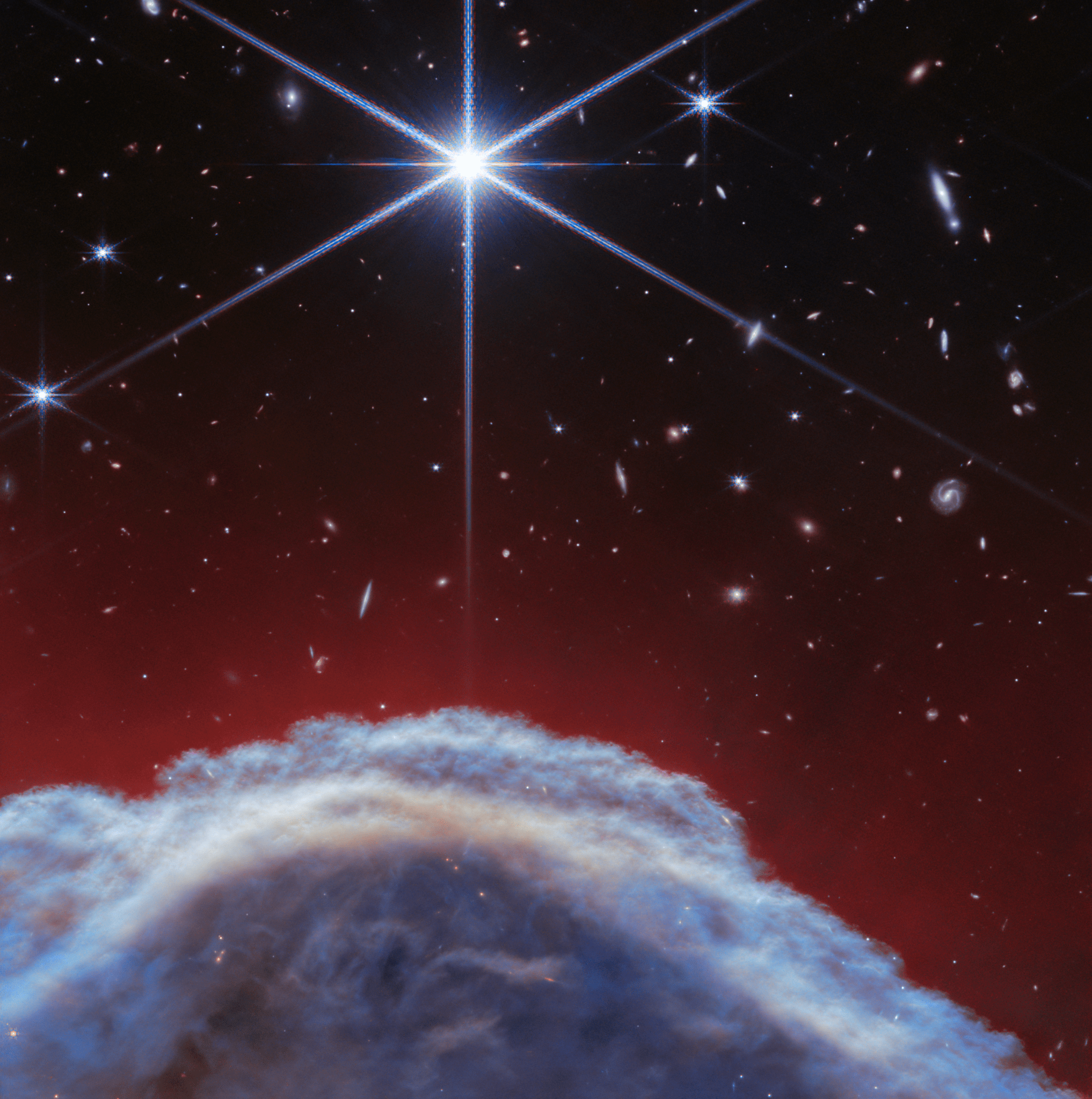Boeing’s Starliner spacecraft approaches the International Space Station. NASA astronauts Butch Wilmore and Suni Williams will launch aboard Starliner on a United Launch Alliance Atlas V rocket for NASA’s Boeing Crew Flight Test. Credits: NASA NASA will provide live coverage of prelaunch and launch activities for the agency’s Boeing Crew Flight Test, which will carry NASA astronauts Butch Wilmore and Suni Williams to and from the International Space Station. Launch of the ULA (United Launch Alliance) Atlas V rocket and Boeing Starliner spacecraft is targeted for 10:34 p.m. EDT Monday,…
Read MoreMonth: April 2024
The Horse’s Mane
Rising from turbulent waves of dust and gas is the Horsehead Nebula, otherwise known as Barnard 33, which resides roughly 1300 light-years away. The NASA/ESA/CSA James Webb Space Telescope has captured the sharpest infrared images to date of one of the most distinctive objects in our skies, the Horsehead Nebula. Webb’s new view focuses on the illuminated edge of the top of the nebula’s distinctive dust and gas structure. This image of part of the Horsehead Nebula, captured by NASA’s James Webb Space Telescope and released on April 29, 2024, shows…
Read MoreNASA Sets Coverage for Dragon Spacecraft Relocation on Space Station
The SpaceX Dragon crew spacecraft pictured from the International Space Station. Credit: NASA In preparation for the arrival of NASA’s Boeing Crew Flight Test, four crew members aboard the International Space Station will relocate the SpaceX Dragon crew spacecraft to a different docking port Thursday, May 2, to make way for Boeing’s Starliner spacecraft. NASA will provide live coverage of the move beginning at 7:30 a.m. EDT on NASA+, NASA Television, the NASA app, YouTube, and the agency’s website. Learn how to stream NASA TV through a variety of platforms…
Read MoreMars exploration, new rockets and more: Interview with ESA chief Josef Aschbacher
Shaping an ambitious and steady space agenda for Europe requires not only diplomatic aplomb but also a firm grounding in science and engineering. Indeed, those attributes are must-haves in working with the 22 member states of the European Space Agency (ESA). Josef Aschbacher is ESA’s director general, taking on that role in March 2021. He is responsible for evolving Europe’s space infrastructure, from rockets and spacecraft performing Earth observation, navigation, and telecommunication duties to robotic planetary exploration, as well as the ESA astronauts serving aboard the International Space Station. “It’s…
Read MoreEverything we know about James Gunn’s Superman
Starting with his Superman reboot, James Gunn (Guardians of the Galaxy movies, The Suicide Squad) aims to reshape DC’s shared universe across movies and TV. Here’s everything we know so far. From Man of Steel to Aquaman and the Lost Kingdom, the DC Extended Universe (DCEU) has had its ups and downs. Its biggest issue being the mix of director-driven ambitions with muddled, inconsistent universe-building. While there were some remarkable wins, it never fully came together. DC Studios, the new hub coordinating all of DC’s efforts outside of comic books,…
Read MoreSneak peek: Browncoats grab victory in Boom! Studios’ upcoming ‘Firefly: ‘Verses’ comic (exclusive)
Everybody loves an invigorating space-based yarn that employs speculative interpretations of historic events — especially if that alternative reality is set within the rough-and-tumble world of “Firefly,” joining Capt. Mal Reynolds and his charismatic crew aboard the spaceship Serenity. Presenting a very different outcome in which the Alliance was defeated and the rebellious Browncoats triumphed in The Unification War 500 years in the future, Boom! Studios and 20th Century Television will release “Firefly: ‘Verses #1” on July 24, 2024. It’s a special one-shot launched from the iconic “Firefly” universe, written…
Read MoreRussia vetoes UN resolution against nuclear weapons in space
Russia vetoed a United Nations resolution that was aimed at preventing a nuclear arms race in space. The resolution was sponsored by the United States and Japan and called upon all nations to never deploy nuclear weapons in outer space. The resolution comes on the heels of recent reports that Russia is developing a nuclear anti-satellite weapon of some kind. The furor caused by the reports led the White House to issue a statement that the rumored weapon poses “no immediate threat to anyone’s safety.” Thirteen nations, including the United…
Read MoreBeavers are helping fight climate change, satellite data shows
As global warming intensifies droughts, floods and wildfires around the world, scientists in western United States are turning to beavers to help reverse some of the damage. Scientists at Utah’s Boise State University and Utah State University are using satellite data to identify streams where once-eradicated beavers can be re-introduced to boost vegetation. They’re also recording how water abundance and vegetation bordering those streams changes once beavers return — metrics of environmental health. “The real value of using satellite data for monitoring is that there are people on the ground…
Read MoreAstronomers just discovered a comet that could be brighter than most stars when we see it next year. Or will it?
This article was originally published at The Conversation. The publication contributed the article to Space.com’s Expert Voices: Op-Ed & Insights. Jonti Horner is an astronomer and astrobiologist based at the University of Southern Queensland, in Toowoomba, Queensland. Hot on the heels of the disappointing Green Comet, astronomers have just discovered a new comet with the potential to be next year’s big story – C/2023 A3 (Tsuchinshan-ATLAS). Although it is still more than 18 months from its closest approach to Earth and the sun, comet Tsuchinshan-ATLAS already has social media buzzing, with optimistic articles being…
Read MoreWatch 2 gorgeous supernova remnants evolve over 20 years (timelapse video)
When we picture what’s in deep space, we often think of static images — colorful composites of distant objects like nebulas and galaxies, frozen in time. The reality is that everything is moving, and it’s moving fast. But given the vast distances involved, it’s hard for us to see that motion. NASA’s Chandra X-Ray Observatory, however, has been taking images for decades — long enough to compile timelapses that show the movement of deep space objects. And the team has just released two such “movies,” one of the iconic Crab…
Read More








